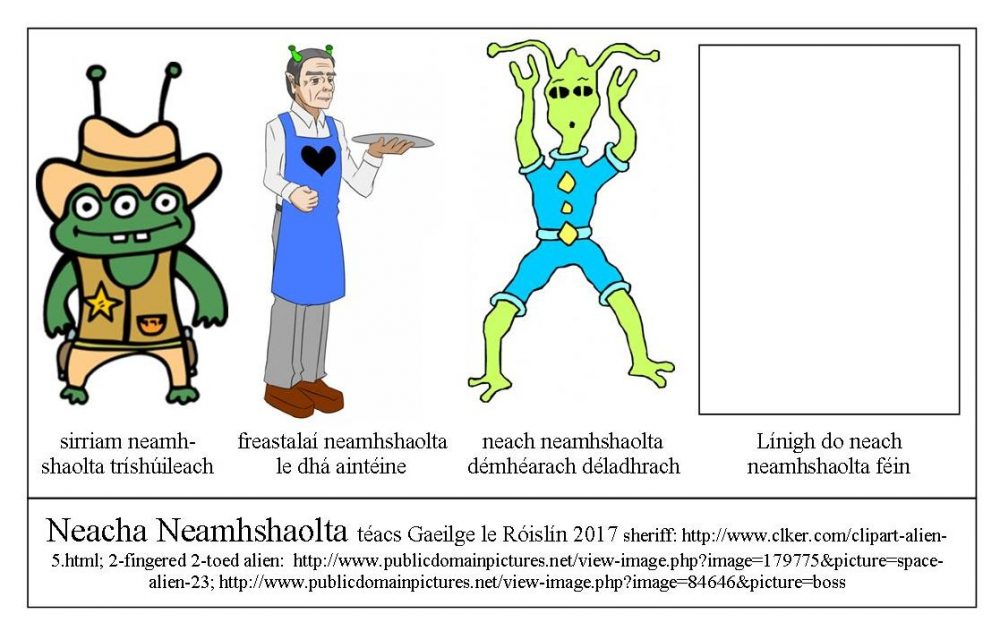Design Your Own ‘Neach Neamhshaolta’ and Describe It in Irish, or, What’s the Gaeilge for ‘I Have Two Antennae, or Three Eyes or Four Opposable Thumbs’? Posted by róislín on Feb 22, 2017 in Irish Language
(le Róislín)
 One of our recent blogposts (nasc thíos) had a fun segue between “neacha neamhshaolta” and “clocha sneachta,” normally a rather unlikely combination. Why so “neamhghnách” (unlikely)?
One of our recent blogposts (nasc thíos) had a fun segue between “neacha neamhshaolta” and “clocha sneachta,” normally a rather unlikely combination. Why so “neamhghnách” (unlikely)?
Bhuel, “neacha neamhshaolta” means “aliens” (in the outer-space sense) and “clocha sneachta” means “hailstones,” normally unconnected. You may remember the photo (an nasc céanna, thíos) of the eerily luminescent (lonrach) and semi-transparent (leath-thrédhearcach) hailstone which to my wondering eye looked like the brain (inchinn) of some alien species, a type with translucent skin so you could see their brains working. I’m sure I’ve seen such beings in some scannán ficsean eolaíochta (science-fiction film) or other. Normally, a hailstone is fairly smooth (mín) and spherical (sféarúil), but the one in the photograph used to illustrate the recent blog was an aggregate (comhbhailithe) one, so the surface reminded me of the ridges (iomairí, or anatomically, gíris) and grooves (eitrí, or anatomically, sulcais) of a brain. Inside the hailstone, you could see the smaller irregularly shaped hailstones that had clumped together.
Anyway, describing aliens from outer space is always good language practice, since it stretches the limits of our imagination. So here are some possibilities and you may want to think of some more features for the neach neamhshaolta that you design yourself.
These sentences are all written in the first person (I have two antennae, etc.), using “agam,” as if the “neach” were speaking him or herself, or, given that we’re talking about spás amuigh (outer space), maybe I should add, “or whateverself.” But if you want to adjust them, you can easily use words like:
aige (at him), for “he has”
aici (at her), for “she has”
acu (at them), for “they have”
The sentences below are based on the pictures in the illustration above. Of course, there are a great many varieties of denizens of outer space, ranging from Ambassador Kollos, a Medusan, from Star Trek‘s “Is There in Truth No Beauty?” (1968) to Jaba the Hutt, Wookies, and the adorable Ewoks (Star Wars) , not to mention the cunning Kanamits (Twilight Zone), the dangerous Daleks (Doctor Who), the and the far-from-naive Na’vi (Avatar), plus, of course, the old standbys, the Martians and the Venusians. As far as describing muintir an spáis amuigh goes, no holds are barred and the world (an domhan), or should I say the multiverse (an ilchruinne) is your oyster (oisre), to blatantly borrow an English idiom.
Good luck describing Ambassador Kollos, by the way! Anyone who looked upon him was supposed to go insane, which is why he traveled totally contained in a box, with his companion, Miranda to guide his travels.
And here are some sample sentences:
Tá dhá aintéine ghlasa agam. I have two green antennae.
Tá trí shúil agam. I have three eyes.
Tá ceithre ordóg agam ar féidir iad a chur i gcoinne na méar. I have four opposable thumbs.
Got a favorite alien from outer space, or extraterrestrial? Feel free to write a description in Irish here — I’m sure other followers of this blog would enjoy reading it, and perhaps picking up a some interesting new vocab. Some of the features you might describe are dath agus tréshoilseacht an chraicinn (má tá craiceann i gceist), cruth an chinn, infheictheacht na hinchinne, an modh cumarsáide, an airde, suíomh na súl (ar ghais nó sa cheann), srl. SGF — Róislín
nasc: Cineálacha Frasaíochta (Irish Terms for Types of Precipitation: Rain, Snow, Sleet, Hail)Posted by róislín on Feb 16, 2017 in Irish Language

Build vocabulary, practice pronunciation, and more with Transparent Language Online. Available anytime, anywhere, on any device.




Leave a comment: